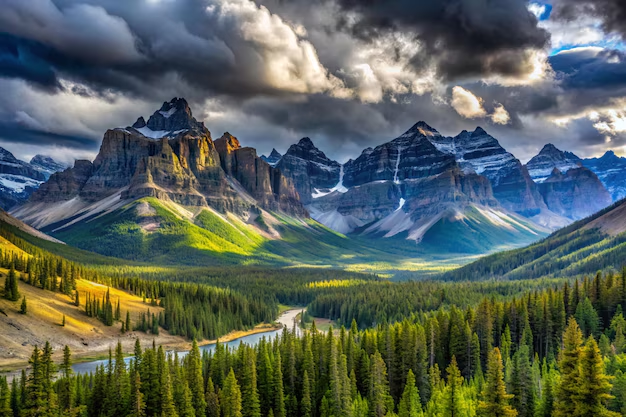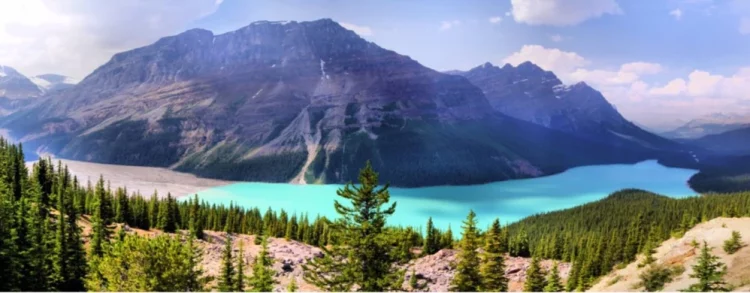Introduction
The Rocky Mountains, often referred to as the Rockies, represent one of the most iconic mountain ranges in North America. Extending over 3,000 miles from Canada’s Yukon Territory, through the United States, and all the way to New Mexico, the Rockies offer a vast and diverse landscape. They are famous not only for their towering peaks and rugged terrain but also for their unique ecosystems, rich biodiversity, and the numerous rivers and lakes that carve through the region. The natural scenery of the Rocky Mountains encompasses a wide range of geographical features, from alpine meadows and dense forests to vast, windswept plateaus and pristine lakes. Understanding the natural beauty of the Rocky Mountains is a journey in itself, as it offers insights into the interplay between geography, climate, and wildlife.
In this article, we will explore the various facets of the Rocky Mountains’ natural scenery, diving into its geography, flora, fauna, weather patterns, and key attractions that make it a natural wonder. Whether you’re a seasoned adventurer or a nature enthusiast planning your first visit, this guide will provide you with all the details you need to appreciate the immense beauty of this mountain range.
Section 1: Geography of the Rocky Mountains
The Rocky Mountains stretch across North America, providing a dramatic landscape of alpine peaks, valleys, and plateaus. This section will detail the geographical layout of the Rockies, examining:
- Location and Range: An overview of the Rocky Mountain range, from the northernmost peaks in Canada’s Yukon Territory to the southern reaches in New Mexico. Discuss the various states and provinces through which the Rockies pass, such as Montana, Colorado, Wyoming, and Alberta.
- Mountain Peaks: Highlight some of the most famous and notable peaks in the range, including Mount Elbert (Colorado), Mount Robson (British Columbia), and Longs Peak (Colorado). Mention how the Rockies are home to several of the highest points in North America.
- Rivers and Lakes: Discuss the rivers (like the Colorado River, the Snake River, and the Columbia River) that originate in the Rockies and their importance to the surrounding ecosystems. Provide information about the famous lakes, including Lake Louise in Canada and Grand Lake in Colorado.
- Geological History: Briefly delve into the geological formation of the Rockies, including how tectonic plate movement and volcanic activity shaped the region’s terrain over millions of years.
Section 2: Climate and Weather Patterns
The climate in the Rocky Mountains varies greatly depending on the elevation and the specific region. The mountains are known for experiencing extreme variations in weather, from sunny skies to sudden snowstorms. Here, we will explore the following:
- Temperature Ranges: Discuss the general temperature ranges experienced in the Rockies, from the alpine regions at higher altitudes to the lower valleys. For example, the difference between summer and winter temperatures, and the extremes of temperature in different areas.
- Precipitation and Snowfall: Analyze the weather patterns that bring precipitation to the region, including seasonal snowstorms in the winter months. Explore the phenomenon of the snowpack and how it affects the region’s ecosystems and wildlife.
- Best Time to Visit: Provide advice on the best seasons for exploring the Rockies. While the summer months (June to September) are perfect for hiking and outdoor activities, the winter months (November to March) attract visitors seeking snow sports.
Section 3: Flora and Fauna of the Rocky Mountains
One of the most remarkable aspects of the Rocky Mountains is the diversity of life it supports. From towering pine forests to alpine meadows, the flora and fauna of the Rockies are vast and varied. This section will cover:
- Vegetation Zones: Discuss the different plant life found in the Rockies, including dense forests of ponderosa pine and Douglas fir in lower elevations and the alpine meadows at higher elevations. Explore the role of wildflowers in the ecosystem.
- Wildlife: The Rockies are home to a wide range of wildlife. Mention iconic species such as elk, bighorn sheep, black bears, and mountain lions. Highlight the importance of conserving these species and the challenges they face due to human activity.
- National Parks and Wildlife Sanctuaries: Introduce visitors to some of the top wildlife viewing spots in the Rockies, such as Yellowstone National Park, Rocky Mountain National Park, and Banff National Park. Discuss the importance of preserving these habitats.
Section 4: Key Scenic Attractions
No visit to the Rockies is complete without experiencing its most spectacular scenic landmarks. This section will delve into the famous natural attractions that visitors flock to, including:
- Glacier National Park (Montana): Known for its rugged terrain, glacial lakes, and towering peaks, Glacier National Park offers breathtaking views. Visitors can hike along Going-to-the-Sun Road and explore the park’s spectacular glaciers.
- Yellowstone National Park (Wyoming, Montana, Idaho): Yellowstone is famous for its geothermal features like Old Faithful and the Grand Prismatic Spring. It is also a sanctuary for wildlife and offers stunning vistas across volcanic landscapes.
- Rocky Mountain National Park (Colorado): A prime destination for hikers and nature enthusiasts, Rocky Mountain National Park features over 300 miles of hiking trails, pristine lakes, and incredible mountain views.
- Banff National Park (Alberta, Canada): This UNESCO World Heritage site is home to towering peaks, glacial lakes, and lush forests. Visitors can explore the iconic Lake Louise and the picturesque Icefields Parkway.
- The Maroon Bells (Colorado): Known for its dramatic peaks and beautiful reflection in the surrounding lakes, the Maroon Bells are some of the most photographed mountains in the world.

Section 5: Adventure Activities and Outdoor Exploration
The natural beauty of the Rocky Mountains offers endless opportunities for outdoor activities. This section will explore some of the most popular activities, such as:
- Hiking and Backpacking: From easy scenic walks to strenuous multi-day hikes, the Rockies offer a range of hiking experiences. Trails like the Longs Peak Trail, the Maroon Bells-Snowmass Wilderness, and the Skyline Trail are popular options.
- Rock Climbing: The rugged terrain of the Rockies provides excellent rock climbing opportunities for all skill levels. The Flatirons near Boulder and the cliffs of Eldorado Canyon State Park are famous climbing spots.
- Wildlife Watching: The Rockies offer abundant opportunities for wildlife watching, from spotting bears and wolves in the wild to birdwatching in the national parks. Be sure to explore the designated wildlife viewing areas.
- Winter Sports: The region is a haven for winter sports enthusiasts, with famous ski resorts such as Aspen, Vail, and Jackson Hole. Snowboarding, skiing, and snowshoeing are just a few of the popular activities.
- Fishing and Water Sports: With its rivers, lakes, and reservoirs, the Rockies are a great place for fishing, kayaking, and canoeing. Popular spots include the Colorado River and the lakes of Banff.
Section 6: Preservation and Conservation
The natural scenery of the Rockies is fragile, and preserving it is critical for future generations. This section will explore the ongoing efforts to protect the environment, including:
- Conservation Efforts: Discuss the efforts being made to conserve endangered species, protect national parks, and minimize human impact on the environment.
- Sustainable Tourism: Examine the role of responsible tourism in the Rockies, including eco-friendly practices and sustainable travel options for visitors who want to leave a minimal footprint.
- Climate Change: Address the challenges posed by climate change, such as melting glaciers and changing ecosystems, and how it impacts the region’s natural beauty.
Conclusion
The natural scenery of the Rocky Mountains is not just a sight to behold, but an experience to be treasured. From its towering peaks to its lush valleys, pristine lakes, and diverse wildlife, the Rockies are a testament to the raw beauty of nature. Whether you’re hiking the trails, skiing the slopes, or simply soaking in the incredible vistas, the Rockies are a destination that will leave a lasting impression on any traveler. By understanding the geography, climate, flora, fauna, and conservation efforts in the Rockies, visitors can gain a deeper appreciation for the wonder and importance of this breathtaking landscape.





















